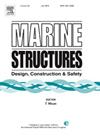Theoretical modeling of simplified offshore wind turbines with monopile support under multiple environmental load coupling
IF 5.1
2区 工程技术
Q1 ENGINEERING, CIVIL
引用次数: 0
Abstract
A theoretical framework is formulated to examine the simplification methodology for monopile-supported offshore wind turbine systems (OWTs), where soil-monopile interactions are represented as a spring-damper mechanism under multi-hazard conditions involving earthquake, wave, and wind loads. The study begins by establishing an integrated OWTs model incorporating interdependent physical phenomena: three-dimensional spring-damping elements characterize soil-monopile dynamics, hydrodynamic impedance functions quantify water-monopile interactions in submerged conditions, linearized wave equations govern wave loads, while wind loads acting on rotor blades. The dynamic behavior of OWTs is subsequently analyzed through three methodological components: implementation of domain-specific boundary constraint formulations, decomposition of scalar potential fields, and application of state-space transfer matrix techniques. Comparative validation protocols demonstrate the computational precision of the proposed non-simplified analytical framework relative to established reference methodologies, while systematic benchmarking reveals critical distinctions between this rigorous solution and conventional spring-damper approximations. Parametric sensitivity investigations are subsequently conducted using the developed model to quantify influential design variables. These analytical advancements establish a theoretical foundation for optimized numerical modeling of offshore wind energy infrastructure, particularly in addressing the multi-physical coupling inherent in monopile-supported structural systems.
多环境荷载耦合下简化单桩支撑海上风力机理论建模
本文建立了一个理论框架来检验单桩支撑海上风力涡轮机系统(OWTs)的简化方法,其中土壤-单桩相互作用被表示为涉及地震、波浪和风荷载的多灾害条件下的弹簧-阻尼机制。该研究首先建立了一个包含相互依存物理现象的综合OWTs模型:三维弹簧-阻尼元件表征土壤-单桩动力学,水动力阻抗函数量化水下条件下水-单桩相互作用,线性化波动方程控制波浪荷载,而风荷载作用于转子叶片。随后,通过三个方法学组件分析了owt的动态行为:特定领域边界约束公式的实现、标量势场的分解和状态空间转移矩阵技术的应用。对比验证协议证明了所提出的非简化分析框架相对于既定参考方法的计算精度,而系统基准测试揭示了这种严格解决方案与传统弹簧-阻尼器近似之间的关键区别。随后使用开发的模型进行参数敏感性调查,以量化有影响的设计变量。这些分析上的进步为海上风能基础设施的优化数值建模奠定了理论基础,特别是在解决单桩支撑结构系统中固有的多物理耦合问题方面。
本文章由计算机程序翻译,如有差异,请以英文原文为准。
求助全文
约1分钟内获得全文
求助全文
来源期刊

Marine Structures
工程技术-工程:海洋
CiteScore
8.70
自引率
7.70%
发文量
157
审稿时长
6.4 months
期刊介绍:
This journal aims to provide a medium for presentation and discussion of the latest developments in research, design, fabrication and in-service experience relating to marine structures, i.e., all structures of steel, concrete, light alloy or composite construction having an interface with the sea, including ships, fixed and mobile offshore platforms, submarine and submersibles, pipelines, subsea systems for shallow and deep ocean operations and coastal structures such as piers.
 求助内容:
求助内容: 应助结果提醒方式:
应助结果提醒方式:


